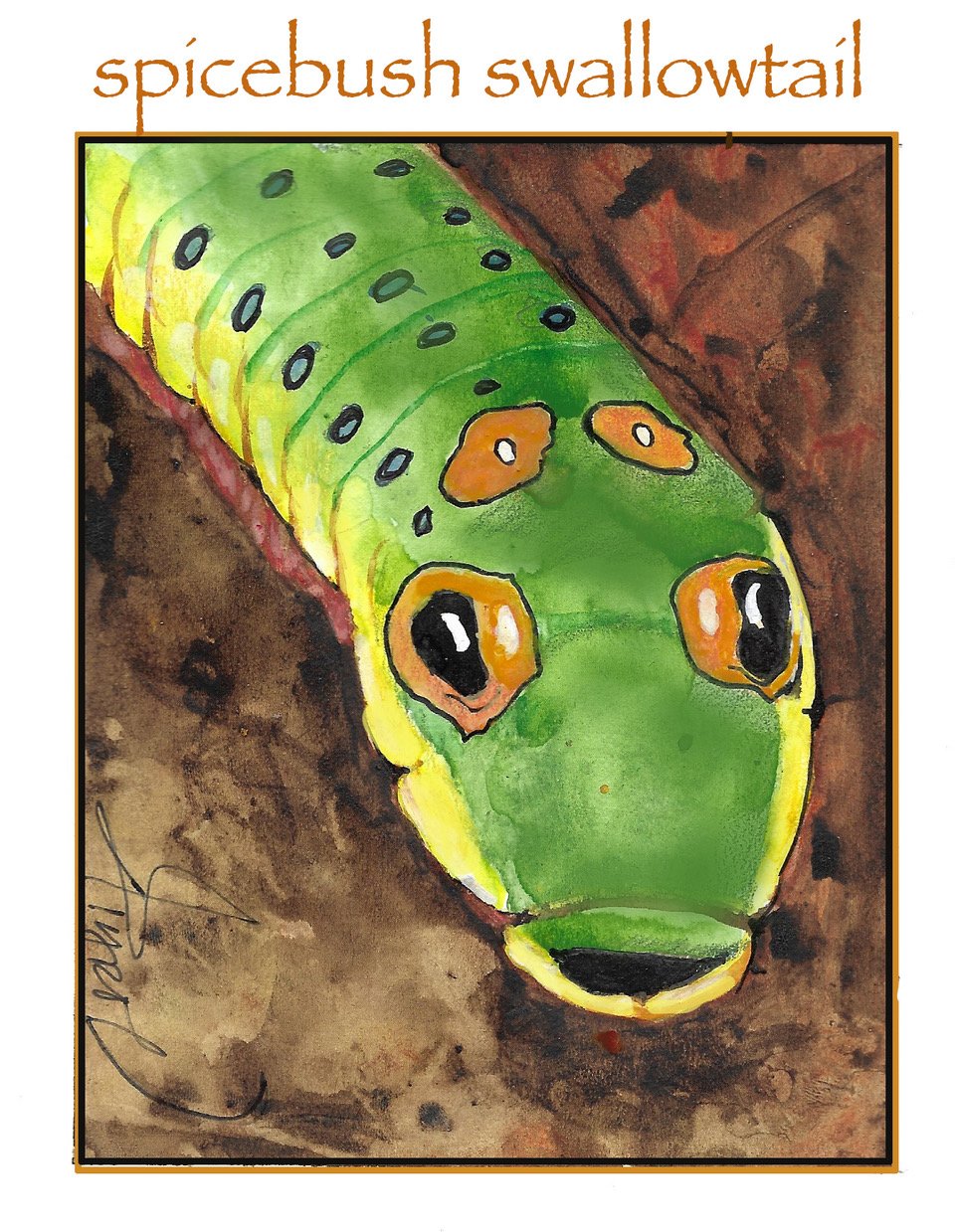The many, varied ways caterpillars avoid predation
June 5, 2024 | By Dian Parker | The Outside StoryIllustration by Adelaide Murphy Tyrol
In “Alice’s Adventures in Wonderland” by Lewis Carroll, Alice stumbles upon a large mushroom. She peeps over the edge and encounters a caterpillar “smoking a long hookah, and taking not the slightest notice of her or anything else.” If Alice had touched the creature, she might have been in for an even bigger shock – forked horns, nasty smells, and other repellent tricks.
There are many animals that prey on caterpillars – including birds, spiders, other insects, and mammals. Migratory warblers, for example, eat one and a half times their body weight in caterpillars every day. It’s no wonder these fat, juicy morsels are a favorite food source: caterpillars can gain up to 20% of their body weight in one hour! Their daily agenda is simple: eat, eat, avoid being eaten, and eat some more. To protect themselves, many caterpillars have adapted ingenious, varied, and seemingly outrageous defense mechanisms.
Monarch caterpillars, for instance, have two related defensive traits: toxicity and warning colors. From the time they hatch until they spin their chrysalises, monarchs famously feed exclusively on milkweed, thereby ingesting the plant’s toxins. Those toxins are repulsive to birds and other would-be predators – and they’re unlikely to make the mistake of munching on a monarch twice. That’s where the monarch caterpillar’s bold yellow and black stripes – and its bright coloring as an adult butterfly – come into play, as a warning that this potential meal is best avoided.
Red admiral caterpillars feed and also shelter on stinging nettles. This adult red admiral butterfly bends the tips of nettle leaves and fastens its eggs with strands of silk. The resulting larvae feed inside these little tents. At night, they move outside the tent to continue feeding. Home becomes incubation, shelter and food.
The tomato hornworm caterpillar looks eerily like a tomato plant. It is bright green with a red horn on its head along with eight v-shaped markings on its underside ‒ perfect for hiding on the tomato plant. This species also eats potato and pepper plants.
The closely related tobacco hornworm caterpillar, whose range is more southern, spends its larval stage eating the highly toxic tobacco plant. These caterpillars absorb nicotine from the plants into their bloodstream, then vent it out through their skin. The result is a pesticide-like fog that makes it clear to wolf spiders and other predators that they won’t make for a good snack.
The unsightly first instars of swallowtail caterpillars (various species) look like shiny, wet bird droppings, repulsive to insect-eaters. Later instars of black swallowtail caterpillars have stripes similar to monarch caterpillars – essentially a bluff to potential predators, suggesting they are toxic (although they are not). Spicebush swallowtail caterpillars have large eye markings that make them look like snakes. And each swallowtail caterpillar has an orange, y-shaped gland called an osmeterium on its neck which it extends when threatened. This gland emits a strong odor that repels even parasitic wasps and flies which feed on almost anything.
Sphinx and underwing caterpillars cover their tracks as they feed. After eating a leaf, they chew through the stalk that attaches the leaf blade to the stem. By dropping the incriminating foliage to the forest floor, they leave little to reveal their whereabouts. The larva of the wavy-lined emerald moth fashions a camouflaged costume by chewing off pieces of the flower or plant on which it is feeding and affixes these to its back, matching the color and texture of its surroundings.
Many species of caterpillars, including tussock moths, have bristles, or urticating hairs, which can irritate predators (including humans) when touched. Forest tent caterpillars thrash about violently when approached in order to scare away potential predators. Inchworms evade predators by using a silk line to lower themselves down from branches when disturbed. The walnut sphinx caterpillar makes high-pitched whistles that frighten birds.
As the comedian George Carlin once said, “The caterpillar does all the work but the butterfly gets all the publicity.”
Next time you see a caterpillar, take a closer look – but probably best if you don’t touch!
Dian Parker lives in the hills of Vermont, waiting for the monarchs and bats to return to her land. The Outside Story is assigned and edited by Northern Woodlands magazine and sponsored by the Wellborn Ecology Fund of the New Hampshire Charitable Foundation.

